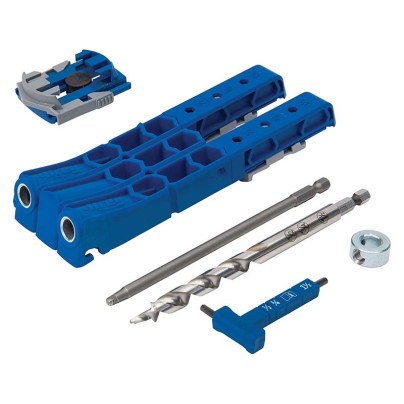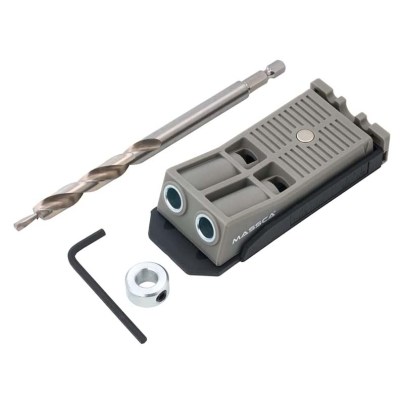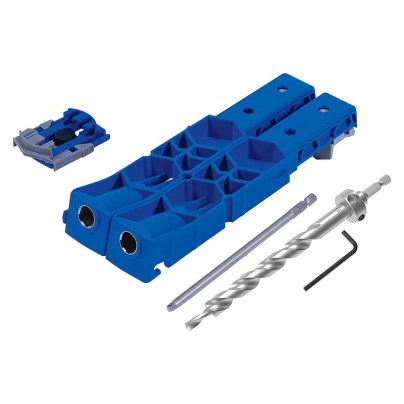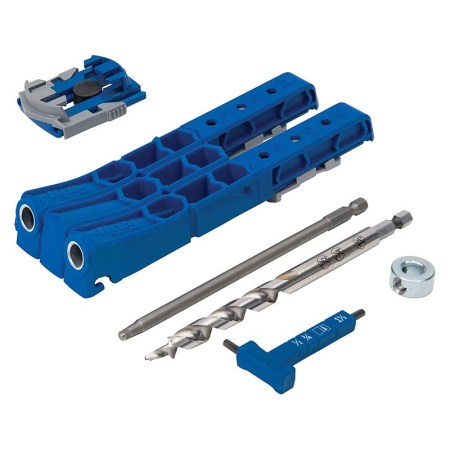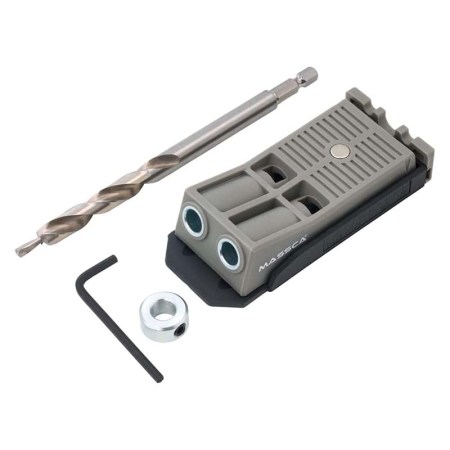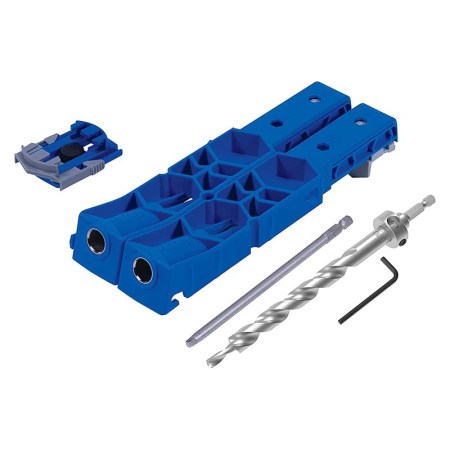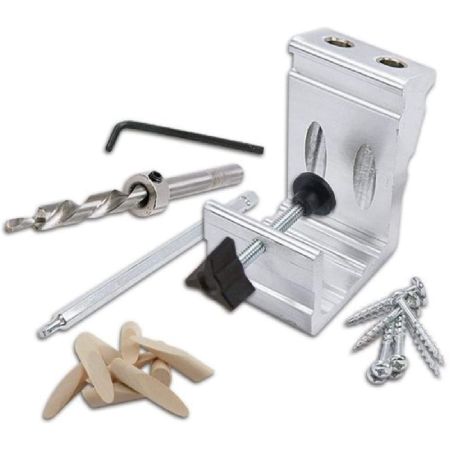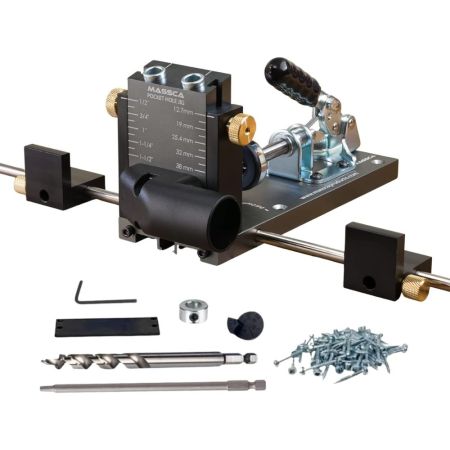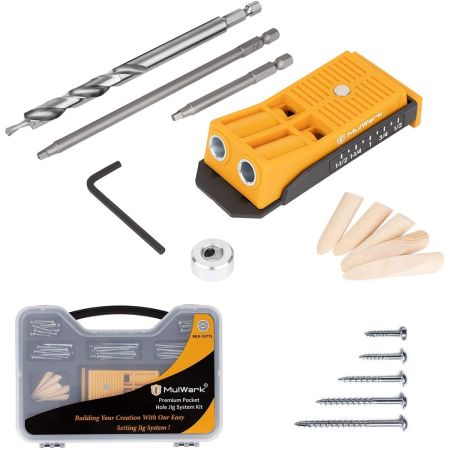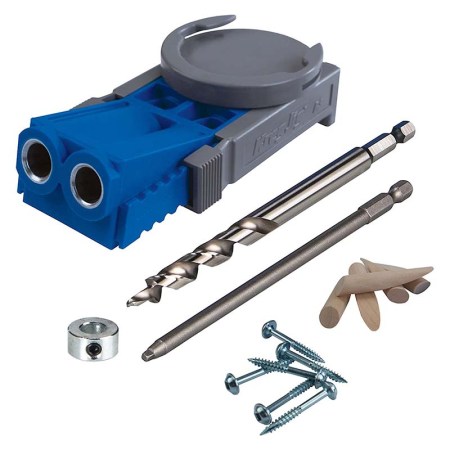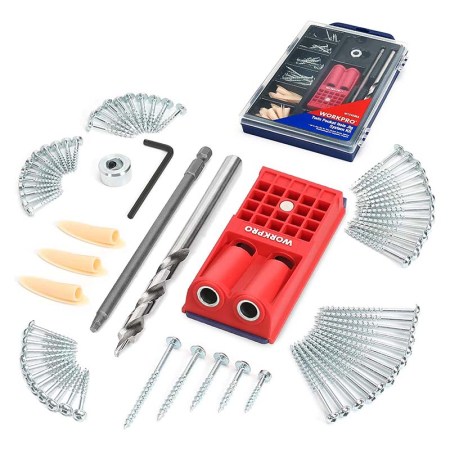We may earn revenue from the products available on this page and participate in affiliate programs. Learn More ›
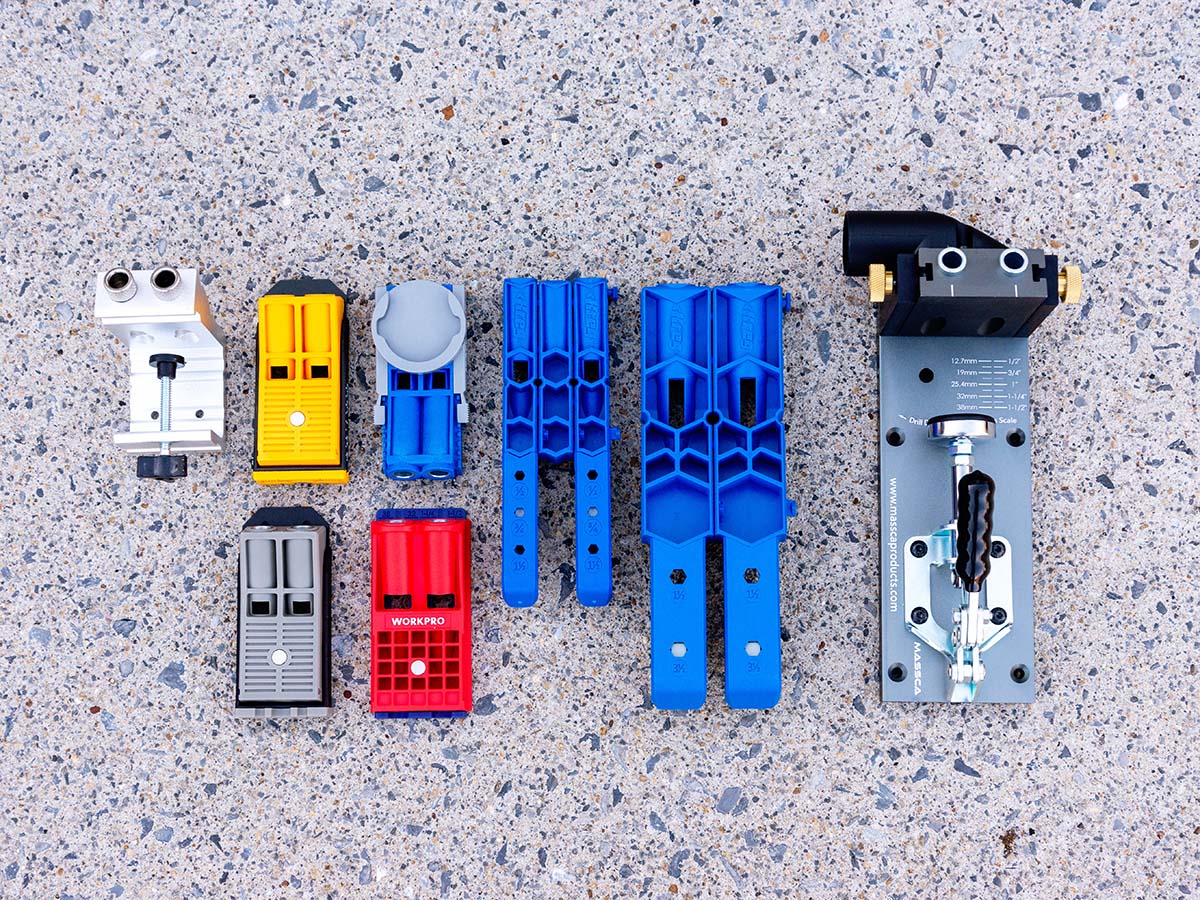
More than just challenging, wood joinery requires a degree of expertise that practically rises to the level of art form. Besides precision and patience, most types of joinery call for expensive tools. There is an exception, however: pocket-hole jigs.
These handy tools make joinery easy and affordable. Even a newbie DIY woodworker can create professional-looking joints without investing hundreds of dollars in tools. Ranging from basic jigs for casual DIYers to large bench-mounted jigs for experienced woodworkers, the following picks rank as some of the top pocket-hole jigs available. We should know—we spent a full day testing them. Find out more about the criteria we used to select this lineup, how we put these tools through their paces, and how each of our picks performed in testing.
- BEST OVERALL: Kreg KPHJ320 Pocket-Hole Jig 320
- BEST BANG FOR THE BUCK: Massca Twin Pocket-Hole Jig Set
- UPGRADE PICK: Kreg KPHJ920 Pocket-Hole Jig XL
- BEST HEAVY-DUTY: General Tools 850 E-Z Pro Deluxe Pocket-Hole Jig Kit
- BEST BUNDLE: Massca M2 Pro Aluminum Pocket-Hole Jig System Bundle
- BEST FOR PICTURE FRAMES: MulWark MLK-53775 Premium Pocket-Hole Jig System Kit
- BEST FOR BEGINNERS: Kreg R3 Pocket-Hole Jig System
- ALSO CONSIDER: WorkPro W124696A Pocket-Hole Jig Kit
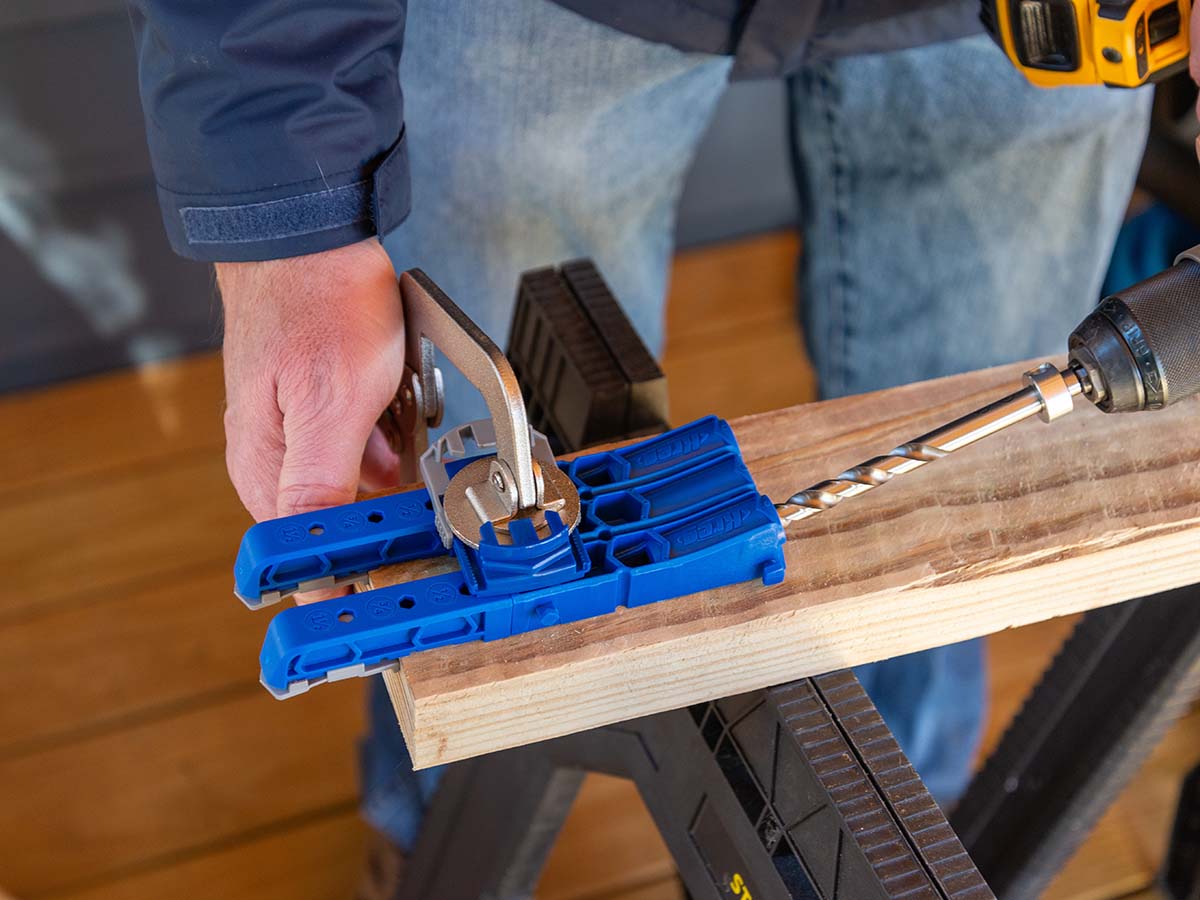
How We Tested the Best Pocket-Hole Jigs
We spent a full day in the workshop testing these pocket-hole jigs in various applications with different kinds of lumber and tracked the results on a scoring rubric. First, we noted the physical measurements of the jigs and the contents of every kit. Then we spent 30 minutes making 20 pocket holes with each jig. Our pocket-hole joinery tests included:
- Miter joint, end-to-end at a 90-degree angle, as in a picture frame corner
- Butt joint, end-to-edge at a 90-degree angle, as in a cabinet face frame
- Box joint, end-to-face at a 90-degree angle, as in the corner of a drawer or wooden box
- Edge joint, edge-to-edge parallel boards, as in a tabletop
- Offset edge joint, edge-to-face at a 90-degree angle, used for structural support
After testing, we recorded our observations in categories like “ease of use,” “perceived quality,” and “value for the price” and scored the tools on a scale of 1 to 4. We used this subjective scorecard and the kit’s facts and features to generate the award titles for this guide.
Our Top Picks
Although there are many types of pocket jigs to choose from, only a handful of manufacturers produce them, including pocket-hole jig inventor Kreg. When we tested the jigs below, each one scored positive marks for ease of use, durability, and functionality. Read on to learn more about them and why we count them among the best pocket-hole jigs around.
Best Overall
Kreg KPHJ320 Pocket-Hole Jig 320
See ItProduct Specs
- Guide holes: 2
- Material:Plastic polymer and hardened steel
- Clamp: Not included
Pros
- Can be reconfigured for 2 wide or 2 narrow-spaced holes, or 1 single-pocket hole
- Durable construction of plastic polymer and hardened steel components
- Includes material thickness stops with locking positive-stop positions
- Drill bit features an engraved depth gauge on the shaft and a see-through depth stop collar
Cons
- Only 3 positive-stop material thicknesses to choose from: ½ inch, ¾ inch, and 1½ inches
The Kreg KPHJ320 is one of the best multipurpose pocket-hole jigs for DIY wood projects. It features two drill guides, a removable spacer, and adjustable stops for ½-, ¾-, and 1½-inch-thick material. The kit comes equipped with a combination hex key/material thickness gauge tool, a stepped drill bit with adjustable depth stop and a stop collar, a clamp adapter pad, and a square drive screwdriver bit. The jig assembly, peripheral tools, and 40 sample pocket-hole screws are well organized in a heavy-duty plastic carry case.
This jig is solidly made with a plastic polymer and hardened steel housing, a nonskid base, and hardened steel drill guide sleeves. The adjustable design makes it an easy choice for most woodworking projects. Slide-and-twist locking tabs on the drill guides and spacer allow the user to reconfigure the assembly for single-hole, narrow double-hole, or spaced double-hole applications. With the addition of more spacers or drill guides (sold separately) the possibilities are endless.
In our tests, the Kreg 320 jig stood out from the pack in terms of versatility, quality, and overall value. The material quality felt strong, and the jig easily gripped the work surface for quick and secure assembly.
In the base configuration, with two drill guides and spacer in place, the jig was conveniently sized for installing pocket holes in the end of 1×4 lumber. We liked this configuration for most of the tests because it allowed us to leave the locking C-clamp attached to the clamp pad for faster repositioning. Then we could drill either one or two holes as needed. For narrow spaces, removing the spacer and attaching the guides to each other made the jig rightsized for end holes in 1×2 lumber.
The slide-lock thickness stops worked extremely well. They were easy to use, clicked securely into place, and accommodated the three most common board thicknesses. To simulate repairs on an existing inside corner, we removed the thickness stops. In that scenario, we visually approximated the required space from the front of the drill guide to the end of the board, using the separated thickness stops for reference.
We also noted that both the nonskid rubber base and the rubber plug by which the clamp pad attaches to the drill guide assembly seem to decrease the amount of clamp pressure required. This makes the whole product easier to work with, and it likely will lead to a longer operational life with less wear and tear. This tool could be a great choice for a wide range of projects, but those who use it for an extended period may wish they could drill downward more easily, rather than sideways.
Read our full review: Kreg KPHJ320 Pocket-Hole Jig 320Get the Kreg KPHJ320 pocket-hole jig at Amazon, Ace Hardware, or The Home Depot.
Best Bang for the Buck
Massca Twin Pocket-Hole Jig Set
See ItProduct Specs
- Guide holes: 2
- Material: Metal and plastic
- Clamp: Not included
Pros
- Compact size and durable, lightweight construction make this a portable choice
- Magnet system fastens to steel clamp pads for easy placement
- Material thickness and depth setting gauges aid in quick setup
Cons
- This jig does not include a carry case, clamp, or starter screws
Often, users may buy a tool only to complete a specific project. Massca’s inexpensive pocket-hole jig set makes an attractive option for the occasional DIYer who only uses a pocket jig set for a few projects a year. This budget-friendly set features two guide holes and includes a drill bit, hex key, and stop collar—pretty much all the necessary pieces to join wood with pocket holes.
Simple to use, this set works with any lumber between ½ inch and 1½ inches thick. It includes a built-in material thickness stop and drill-depth-setting gauge. A built-in magnet secures the quick-change thickness stop plate and makes working with steel clamps fast and easy.
We liked the simplicity of the Massca Twin jig’s one-piece design. The drill guide holes are spaced 1½ inches on center, which proved to be perfect for drilling double-pocket holes in the end of 1×2 lumber. The compact tool was conveniently sized for smaller projects like joining picture frame corners.
Whenever wider spacing was needed, we drilled a single hole per location and repositioned as needed. The embedded magnet worked well with plain steel clamps, at least to avoid dropping the jig on the floor, but some manual repositioning was usually required to set up at the next position.
This was an easy option for on-the-go use. It didn’t take up much room in the tool box and fit comfortably in a tool apron or pocket. However, users will also need to keep track of the drill bit, hex key, and a clamp, since the kit did not include a carry case.
Get the Massca twin pocket-hole jig at Amazon, The Home Depot, or Walmart.
Upgrade Pick
Kreg KPHJ920 Pocket-Hole Jig XL
See ItProduct Specs
- Guide holes: 2
- Material:Polymer and hardened steel
- Clamp: Not included
Pros
- Larger size for creating stronger pocket-hole joints in 2×4 or 4×4 lumber
- Adjustable drill guides for single-hole, narrow double-hole, or wider spacing
- Made with an easy-set depth stop collar and a non-slip adjustable clamp pad
- Durable construction of polymer and steel for long-term reliability
Cons
- Only 2 positions to choose from on the material thickness stops
- Kit does not come with a carry case to keep all of the parts organized
Most pocket-hole jigs are built for small- and medium-size projects using ½-inch to 1½-inch-thick lumber, like framing artwork or building cabinetry. For heavy-duty projects, the Kreg XL jig accommodates posts and timbers from 1½ inches up to 3½ inches thick. This is the right choice when working with 2×4 and 4×4 boards. The kit includes two XL drill guides, a ½-inch diameter XL stepped drill bit with an easy-set depth stop collar, a hex key, a non-slip adjustable clamp pad, and a #3 XL square driver bit.
Like the other Kreg jigs we tested, this model is made of heavy-duty polymer with hardened steel guide sleeves and a nonskid rubber base. The drill guides have removable material thickness gauges and are connected by twist-and-slide locking tabs, allowing the user to reconfigure them for different applications. It’s also important to note the ½-inch drill bit bores the required girth to install Kreg’s #14 2 ½-inch XL pocket-hole screws without splitting the wood. Other pocket-hole jigs work with ⅜-inch drill bits that are matched to smaller screw sizes.
This Kreg jig would make a great tool addition for big jobs. In our tests, it worked as well as the smaller Kreg 320, with just as much versatility, but on a larger scale. Just bear in mind that larger clamps will be required for the thicker boards involved. We used a bar clamp with great success. During testing, we found it easy to achieve incredibly strong joints. While this jig could be a big help for renovations and home upgrades, users should be sure to follow local building requirements for projects like decks and stairs. The simple joint configurations we built while testing this jig may not be appropriate for some structural applications.
While we liked pretty much everything about this tool for big jobs, we noted that it is cumbersome and less useful for smaller woodworking projects. It does not come in its own carry case, so users will want to keep all of the parts and accessories together when not in use.
Get the Kreg XL pocket-hole jig at Amazon, Lowe’s, or Rockler.
Best Heavy-Duty
General Tools 850 E-Z Pro Deluxe Pocket-Hole Jig Kit
See ItProduct Specs
- Guide holes: 2
- Material: Cast aluminum and steel
- Clamp: Integrated
Pros
- Durable and uncomplicated all-metal aluminum and steel construction
- Integrated clamping system reduces the number of required tools
- Comes with a starter set of compatible screws and pocket-hole plugs
- Easily mounts to a tool bench by means of 2 screw holes
Cons
- Fixed clamp depth is not truly compatible with materials thicker than ¾ inch
- Thumb-screw-operated vice clamp is not as convenient as a toggle clamp
Metal trumps plastic when it comes to durability, which makes this pocket jig from General Tools such an attractive option. Machined from a solid piece of cast aluminum, this affordably priced heavy-duty pocket jig will hold up through many pocket drilling projects.
General Tools equips the 850 with an easy-to-use built-in clamping system, which helps speed up projects, and steel drill guide sleeves for added durability. In addition to the jig, this kit includes a drill bit, stop collar, and hex wrench along with a starter set of 50 coarse or fine square screws, 25 wooden picket hole plugs, and a hard plastic carrying case. This pocket-hole jig kit functions as a portable jig or as a bench-mounted tool.
We deem this an excellent choice for anyone in search of a durable pocket-hole jig for use with wood ½ inch to ¾ inch thick. Although the manufacturer states that the General Tools 850 is suitable for wood up to 1½ inches thick, the jig has no adjustment feature that would allow the deeper drilling required for thicker wood. Still, we found it to be very effective and sturdy with thinner boards.
The integrated thumb-screw C-clamp system was easy to align on the ends and edges of boards. Because of the small diameter of the clamp’s pressure plate, we used a 1-inch-square scrap of ¼-inch plywood between the clamp and the work piece to protect the wood surface from indentations.
We also tested this jig in a bench-mounted configuration by driving two screws through the mounting holes. It held firmly and allowed for comfortable vertical drilling. Our overall opinion was that this tool offers an affordable solution for many different pocket-hole projects, but it requires occasional work-arounds to improve accuracy or user comfort.
Get the General Tools pocket-hole jig at Amazon, The Home Depot, or Walmart.
Best Bundle
Massca M2 Pro Aluminum Pocket-Hole Jig System Bundle
See ItProduct Specs
- Guide holes: 2
- Material: Cast aluminum and steel
- Clamp: Integrated
Pros
- Heavy-duty cast-aluminum construction with steel material support system
- Conveniently designed for vertical drilling in a benchtop work setting
- Integrated dust port and face clamp for faster work and faster cleanup
- Sliding material thickness settings with thumbscrews for quick adjustment and precise drilling
Cons
- Significantly more expensive than other pocket-hole jigs
- More cumbersome and less convenient for off-site work outside the shop
The Massca M2 pocket-hole jig system is a great choice for bench-mounted operation, especially for assemblies that call for lots of pocket holes. In its base configuration, the integrated clamp holds workpieces upright for comfortable vertical drilling. When a compact jig is required for projects outside the workshop, the drill guide can be removed from the bench and a portable base installed. This professional-grade system includes all the necessary components to get started:
- cast-aluminum dual drill guide with built-in dust chute
- bench base with integrated toggle clamp
- stabilizer bars
- stop blocks
- turret drill depth gauge
- portable base
- 10-inch face clamp
- ⅜-inch stepped drill bit with stop collar
- square drive screwdriver bit
- 200 assorted starter pocket-hole screws
The Massca M2 costs more than double the second-highest-priced pocket-hole jig in our lineup, and our tests showed why the added cost may be worth it. While the material quality was immediately apparent in the cast-aluminum construction, the smooth operation of the adjustable steel drill guide, and the heavy-duty face clamp, the thoughtful performance and convenience details continued to emerge as we used the tool.
To mount the jig on a benchtop, we drove four screws through the mounting holes in the base plate. (Users also have the option of mounting to a T-track system.) The face clamp simply moved forward and back to hold and release a workpiece, which made the process of positioning workpieces very fast. Adjusting the clamp to the thickness of the wood took a few seconds, but it wasn’t difficult. Once set, it didn’t budge, and releasing it took almost no effort.
When a workpiece was clamped in place, a material thickness gauge printed on the base plate showed how to adjust the drill guide. Brass thumbscrews fixed the adjustable drill guide at the precise location for the thickness of the workpiece, with help from a gauge on the face of the unit. Both gauges were labeled in fractional inches and millimeters. While drilling, the built-in dust port directed drill dust away from the workpiece, and when attached to a vacuum, it eliminated most of the cleanup.
We especially liked the stabilizer bars and depth stop blocks. Set screws inside the base plate held the steel bars in place, and the L-shaped blocks could be used in either of two positions. With the lower limb of the L parallel to the bar, a thumbscrew could tighten the block at any distance from the drill guides for precise repeatable hole placement. Configured with the L perpendicular to the bar, the block assisted in stabilizing long boards for edge drilling.
Get the Massca M2 Pro pocket-hole jig at Amazon, The Home Depot, or Acme Tools.
Best for Picture Frames
MulWark MLK-53775 Premium Pocket-Hole Jig System Kit
See It- Guide holes: 2
- Material: Plastic, re-sulphurized hardened steel, and metal
- Clamp: Not included
Pros
- Embedded magnet makes it easy to set the jig with a steel clamp
- Compact size makes this tool a good fit for working in tight spaces
- Comes with a carrying case that holds bits, jig, screws, and other tools and accessories
Cons
- Depth stops are not prelabeled on the drill bit
- The 2-inch-long square screwdriver bit may be too short for some projects
MulWark’s simple yet effective pocket-hole jig makes a great option for those DIYers looking for an everyday pocket-hole solution for small- to medium-size wood joining projects ranging from picture frames to furniture. This pocket-hole jig kit includes a two-hole jig, a 6-inch and 3-inch square driver bit, a ⅜-inch stepped drill bit, a limiting-depth stop collar, a ⅛-inch hex wrench, fifty screws in various sizes, and a user manual.
This model does not skimp on user-friendliness with over nine jig position settings, nine thickness measure settings, and seven depth settings, all of which accommodate boards of ½-inch to 1 ½ inches. A magnet integrated into the jig body also adds convenience for use with a standard metal clamp while the accessories include five different sizes of course square driver screws and a set of five plastic plugs. This MulWark model also contains a handy carrying case, which makes it easy to keep everything organized and accessible.
The MulWark pocket-hole jig’s compact size and easy adjustability make it a good choice for constructing picture frames. The small size makes it simple to fasten onto the relatively thin, narrow framing material. The strong built-in magnet adheres to steel clamp pads, making it less likely to drop while repositioning from one corner to the next. Plus, the kit includes an assortment of starter hardware that is compatible with a variety of wood types.
Unlike the basic jig set from Massca, this kit came well-organized in a plastic carry case. The case felt a little flimsy, but we liked the ability to keep all of the associated tools and accessories together for storage. Also, the assortment of coarse starter screws comes in five different sizes for hardwood or softwood projects.
Get the MulWark pocket-hole jig at Amazon, MulWark, or Walmart.
Best for Beginners
Kreg R3 Pocket-Hole Jig System
See ItProduct Specs
- Guide holes: 2
- Material:Glass-filled nylon, polymer, and hardened steel
- Clamp: Not included
Pros
- Durably constructed of glass-filled nylon, polymer, and steel
- Adjustable clamp pad makes it easy to reposition the jig for repeated drilling
- Drill bit depth adjustment chart printed inside the bit slot in the carry case
- Kit comes with a hard-sided carry case to keep everything organized
Cons
- Higher price than similarly sized pocket-hole jigs from other manufacturers
Beginner DIYers and woodworkers looking for an uncomplicated pocket-hole jig for a variety of joinery solutions should consider the Kreg R3. It’s just the right size for building and repairing furniture, shelves, cabinetry, and other common household projects and includes convenience features that make it easy to get started right away.
The R3 features glass-filled nylon construction with hardened steel drill guide sleeves for outstanding durability. The built-in clamp pad adaptor allows the jig to be easily secured to the workpiece with any standard bar clamp, C-clamp, or
. Slide-locking material thickness stops on each side of the jig easily adjust among nine settings in ⅛-inch increments from ½ inch to 1½ inches to match the workpiece. The kit also includes a ⅜-inch stepped drill bit with stop collar and hex key, a 6-inch square drive screwdriver bit, fifty assorted pocket-hole screws, and five pocket-hole plugs, all neatly secured in a heavy-duty carry case.
While the Kreg R3 is designed and proportioned similarly to the Massca Twin, MulWark, and WorkPro jigs we tested, several reasons made it stand out as our preferred choice for beginners. Though the R3 was a bit more expensive than the others, it was faster to set up, easier to adjust, and made cleaner holes than the others.
The built-in sliding thickness stops along the sides of the jig made the difference. They allowed space for approximately ⅜ inch longer steel guide sleeves, with the drillexiting immediately in contact with the wood. This configuration supported the drill bit much better than the other jigs and made cleaner pocket holes with excellent accuracy.
The other three jigs used adjustable thickness gauges made of thin polymer that attached beneath the main body of the jig. Their drill bits received less support from shorter steel guide sleeves, comparatively reducing hole cleanliness and accuracy.
The snap-on clamp pad was built to work specifically with the large pad of a Kreg clamp so that the large clamp foot would stay in the slots of the pad, making one convenient assembly for repeat drilling. In our case, however, we used a different clamp brand that didn’t fit quite as well but still held securely. If we removed the clamp pad we had the option to fasten the jig to the workpiece with wood screws.
The carry case was also head and shoulders above anything the competition offered. It was sturdy, held the components securely, and offered adequate free space for a pack of pocket screws. Another bonus: Behind the storage spot for the drill bit, the case was embossed with a depth collar setting guide so that accurate adjustments could be made before removing the bit. Thoughtful design, ease of use, precise operation, and clear instructions make the Kreg R3 one of most user-friendly options for beginners.
Get the Kreg R3 pocket-hole jig at Amazon, Ace Hardware, or The Home Depot.
Also Consider
WorkPro W124696A Pocket-Hole Jig Kit
See ItProduct Specs
- Guide holes: 2
- Material:Plastic, steel, and metal
- Clamp: Not included
Pros
- Affordable price point for an all-inclusive pocket-hole joinery start-up kit
- Thickness stop and drill depth collar gauge sized in both fractions of an inch and millimeters
- Kit includes an assortment of 120 coarse pocket-hole screws in various lengths
Cons
- Lightweight carry case feels too flimsy for frequent use
- Configuration of the thickness stop creates less accurate, less clean holes than top competition
The WorkPro pocket-hole jig kit takes on project pieces from ½ inch to 1½ inches thick. The dual-hole molded plastic jig features hardened steel drill guide sleeves, an adjustable material thickness stop, and a built-in magnetic clamp pad. The kit includes a ⅜-inch stepped drill bit with adjustable depth stop collar and hex key, a square drive screwdriver bit, 120 assorted pocket-hole screws, and 20 pocket-hole plugs.
This jig comes equipped with a built-in material thickness stop that offers nine settings at ⅛-inch increments. The thickness stop includes a drill bit stop collar gauge that eliminates the need for manual measuring. Measurements are shown in both millimeters and fractions of an inch.
In our tests, the WorkPro pocket-hole jig performed similarly to the MulWark and Massca Twin models. It was compact, affordable, effective, and easy to work with. While the holes were slightly less clean and accurate than the Kreg R3, we were generally happy with the results—even more so after sanding them smooth. For occasional repairs, the kit probably includes all the pocket screws most DIYers will ever need. We didn’t love the flimsy carry case, but it should be passable for those who only intend to use the jig occasionally. Also, the plastic hole plugs won’t be compatible with most projects.
Get the WorkPro pocket-hole jig at Amazon, WorkPro Tools, or Walmart.
Jump to Our Top Picks
What to Consider When Choosing a Pocket-Hole Jig
Understanding the range of pocket-hole jig systems available as well as such features as material, number of guide holes, and portability is crucial when shopping for the right pocket jig. Ahead, learn more about these and other attributes of pocket-hole jigs.
Type
Pocket-hole jigs come in various shapes, sizes, and price points. A classic pocket-hole jig system consists of the jig and an integrated clamp that holds the workpiece in place. Jigs on these systems typically have two or three guide holes, which make it easy to drill numerous pocket holes in no time. Some models include supports or mount on benches to help DIYers drill pocket holes into larger workpieces.
Smaller single-hole and double-hole pocket jigs rank as some of the most affordable and compact jigs on the market. Most come with carrying cases that make them great portable options. This type of pocket jig does not include a bench and requires the use of a separate clamp, which makes it suitable for smaller projects.
A multi-hole jig makes a good choice for woodworkers who drill pocket holes frequently, while a single-hole jig suits smaller workpieces or occasional DIY projects that require drilling a few pocket holes. Expandable pocket-hole systems feature one or two drill guides that can be used individually, connected together, or expanded further with the addition of spacers or additional drill guides.
Material
Pocket-hole jigs consist of a molded frame made of high-quality plastic that can withstand clamps without cracking. A hardened steel insert in the jig’s guide holes prevents the drill bit from damaging the jig while drilling.
In addition to the jig itself, the kit should also include the tools necessary to use the jig, including a stepped drill bit that simultaneously creates the pocket hole and a short pilot hole for the screw shank. The kit should also come with a depth collar that fits around the drill bit to control how deep into the wood it drills and a square-headed driver bit for installing the screws.
Jigs without integrated clamp systems require some sort of clamp to fit securely to the workpiece. Some kits include either a C-clamp or face clamp, but often these are sold separately.
Keep in mind that pocket-hole joinery requires special self-tapping square drive screws designed for use with pocket jigs. Most pocket-hole jig kits come with starter packs of pocket-hole screws along with a pocket-hole plug set.
Guide Holes
A pocket-hole jig will have one to three guide holes. These holes serve as a guide for the drill bit and allow it to create pocket holes in the workpiece. Since these guide holes work with the drill bit, they usually have a steel liner that can endure the rotating blade of the drill bit without cracking or wearing out.
Depth Stop
Pocket-hole jigs come with depth stops, which control the drilling depth. These stops consist of a ring-shaped piece of hardened steel. This metal cuff has a set screw in the side that allows the user to tighten it in place on the drill bit using a hex key. This device stops the drill bit when it comes into contact with the jig, preventing the bit from boring deeper into the workpiece.
The depth stop must be positioned on the drill bit at the proper height based on the thickness of the material being drilled. If the collar is too high on the drill bit shank, the drill will bore too deeply, damaging the workpiece; if it’s too low, the screw will not seat below the surface. Most kits include a stop collar gauge that helps the user position the stop collar.
Toggle Clamps
Clamps prevent the jig from shifting while the user drills the holes. The best option for these tools, a toggle clamp allows the user to lock the jig quickly onto the workpiece by pulling a lever. A vice clamp, on the other hand, requires the user to tighten the clamp by turning a screw. Large pocket jig systems have toggle clamps integrated into the jig. Smaller single- and double-hole pocket jigs require the user to attach the clamp to the jig and workpiece separately.
Portability
Some jigs consist of larger systems that include an integrated clamp and allow the user to set up to three holes at a time. While this type of jig works well in a workshop, its bulky size makes it difficult to transport to a jobsite.
Single- and double-hole jigs without integrated clamping systems are much smaller and come with carrying cases, which makes them easy to transport to a remote worksite in a tool bag or even a tool belt. Portable pocket jigs come with a case that keeps the jig and the required drill and drivers together for convenience.
Ease of Use
Pocket-hole jigs make an affordable and easy-to-use alternative to some of the more advanced and expensive methods for joining wood. With that in mind, most manufacturers design their pocket jigs with casual woodworkers and DIYers in mind.
They feature markings that make setting the jig and the depth stop to match the wood thickness easy. Most jigs also come with instructions that clearly describe how to use the jig.
FAQs
If you’re wondering how to set up a pocket jig or what type of jig you should purchase, read on for answers to some of the most commonly asked questions about these handy woodworking tools.
Q. How do I choose a pocket-hole jig?
When deciding on which pocket-hole jig to buy, consider how you’ll use it. If you’re an avid DIYer or pro woodworker who plans to use a pocket jig regularly, purchase a higher-end model that will allow you to work more quickly. For occasional use, there’s no need to splurge on an expensive pocket-hole jig. Instead, go for a more affordable model. If most of your projects take you away from your home workshop, consider purchasing a compact and lightweight pocket jig that’s easy to carry to and from the jobsite.
Q. How do I set up a pocket-hole jig?
Begin by attaching the stop collar onto the drill bit. Set the collar to the thickness mark that matches the thickness of the workpiece. Position the sliders on the jig so that they also match the thickness of the workpiece. Clamp the jig to the piece, making sure to align the guides for the holes to the correct position on the workpiece. Insert the bit into a drill and drill the holes.
Q. How close together can you put pocket holes?
Jigs with more than one guide hole have the holes automatically spaced apart. The distance between the center of one hole to the center of the adjacent hole is typically about 1 inch.
Q. How do you use a pocket-hole jig on a 2×4?
Begin by setting the stop collar on the drill bit and the sliders on the jig to 1½ inches, which is the actual thickness of a 2×4. Attach the jig to the end of the 2×4 using a clamp, making sure to center the jig. Once secure, use a drill with the jig drill bit to make the pocket holes.
Why Trust Bob Vila
Homeowners and DIYers have trusted Bob Vila for reliable and affordable home improvement advice since 1996. Staff writer Mark Wolfe has tested hundreds of tools and gadgets for BobVila.com’s product reviews team. He provides honest and straightforward recommendations based on more than 20 years of professional lawn and garden experience, along with an extensive background in DIY home and automotive repairs.
Meet the Tester
Mark Wolfe is a product tester and writer with an extensive background in the nursery and landscaping industry. He kept his tool box well stocked in order to build or repair fences, walls, irrigation systems, and equipment on any given day. Now he tests and writes reviews about the latest hand tools, lawn-care products, outdoor power equipment, and other outdoor-living goods.
